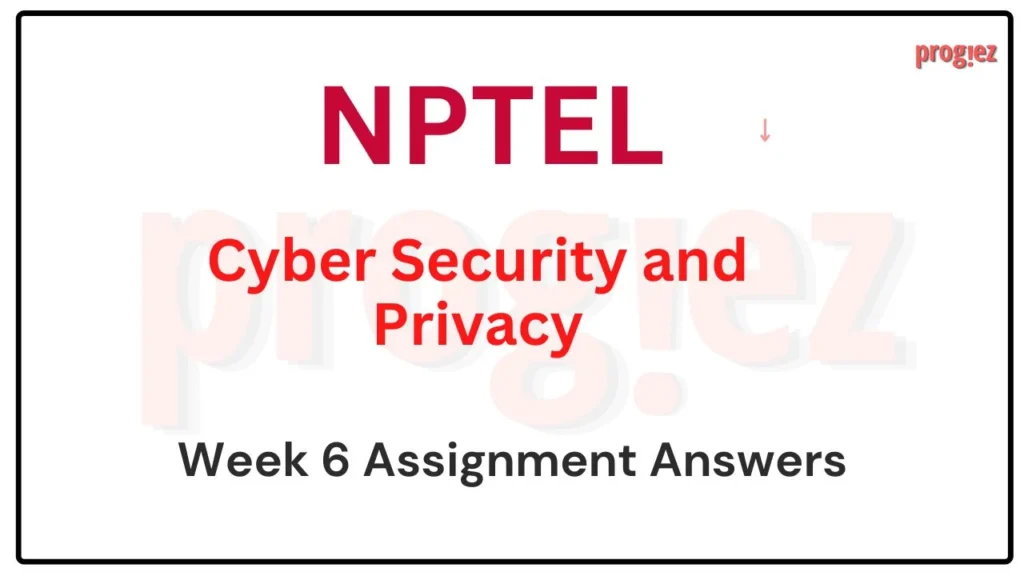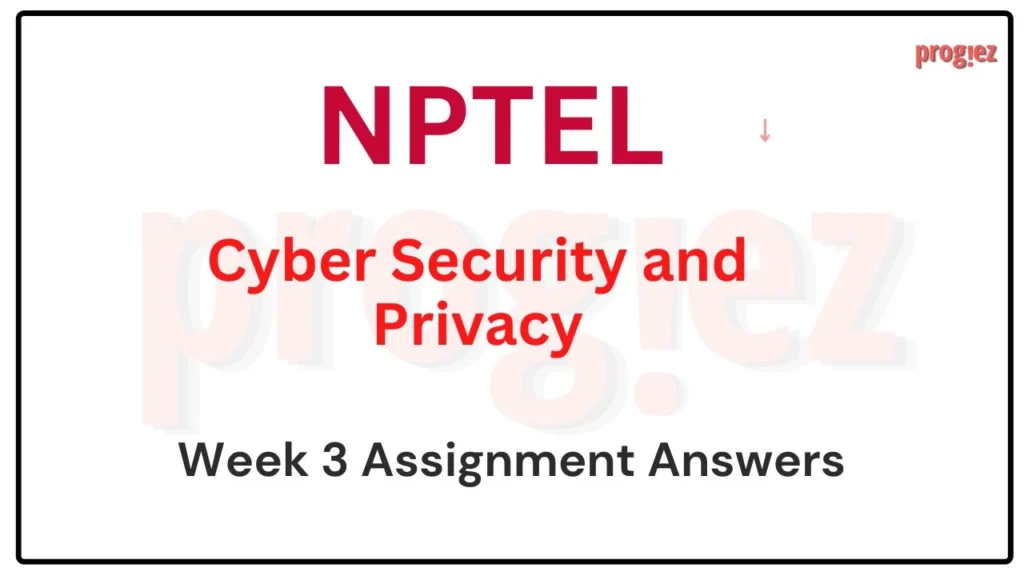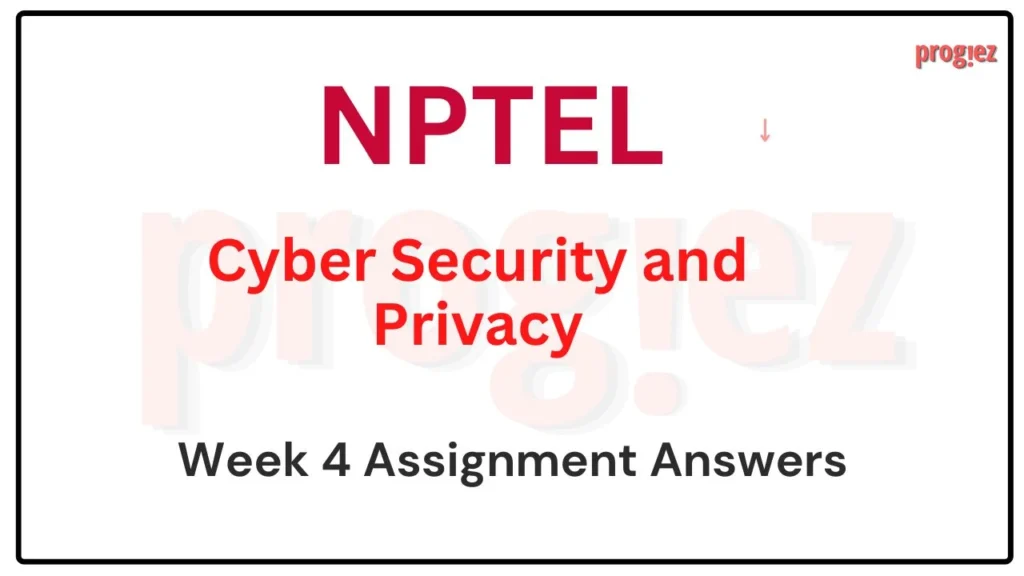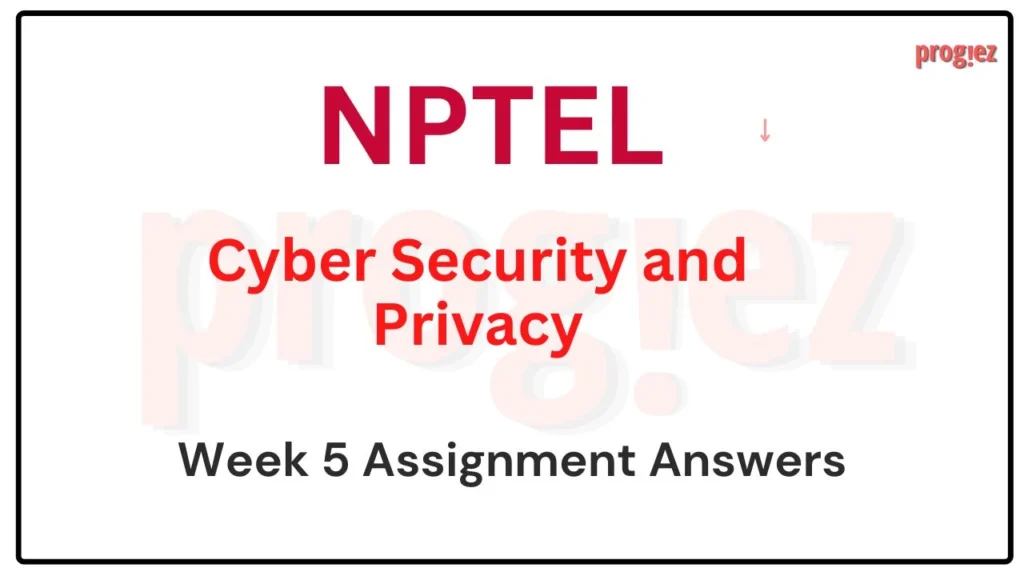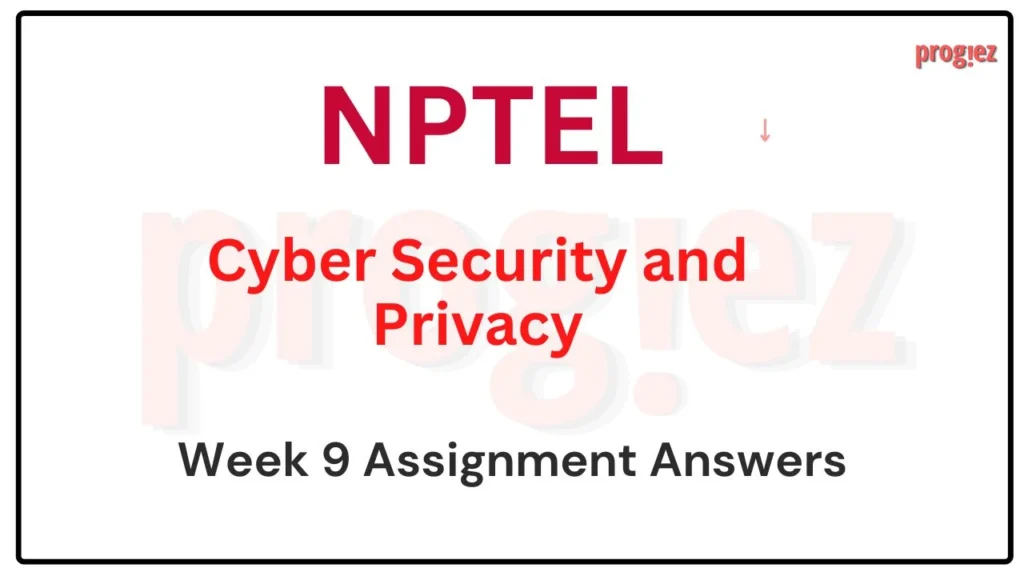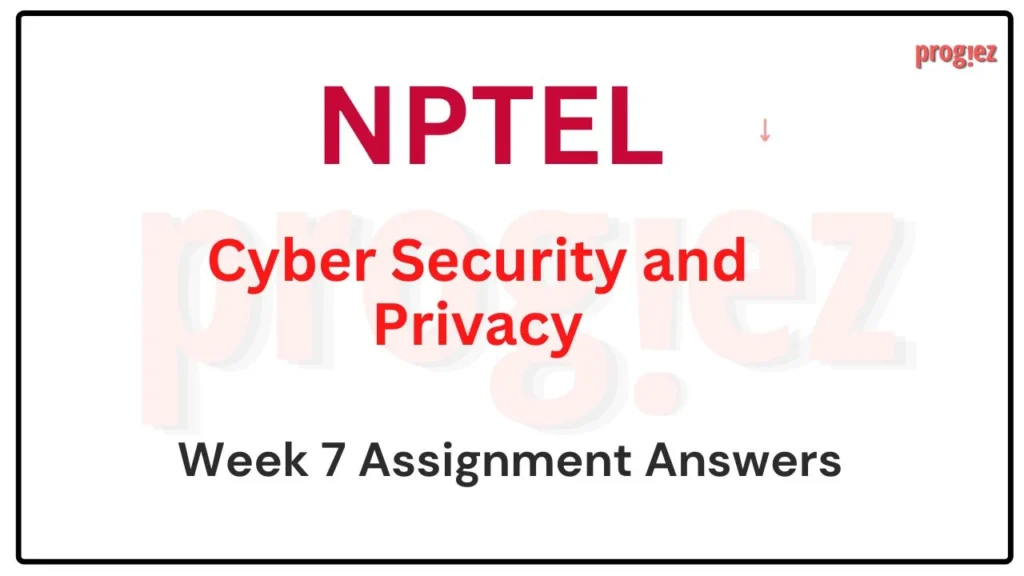Cyber Security and Privacy Week 8 Nptel Answers 2024
Are you looking for Cyber Security and Privacy Week 8 Nptel Answers? You’ve come to the right place! Access the latest and most accurate solutions for your Week 8 assignment in the Cyber Security and Privacy course.
Course Link: Click Here
Table of Contents
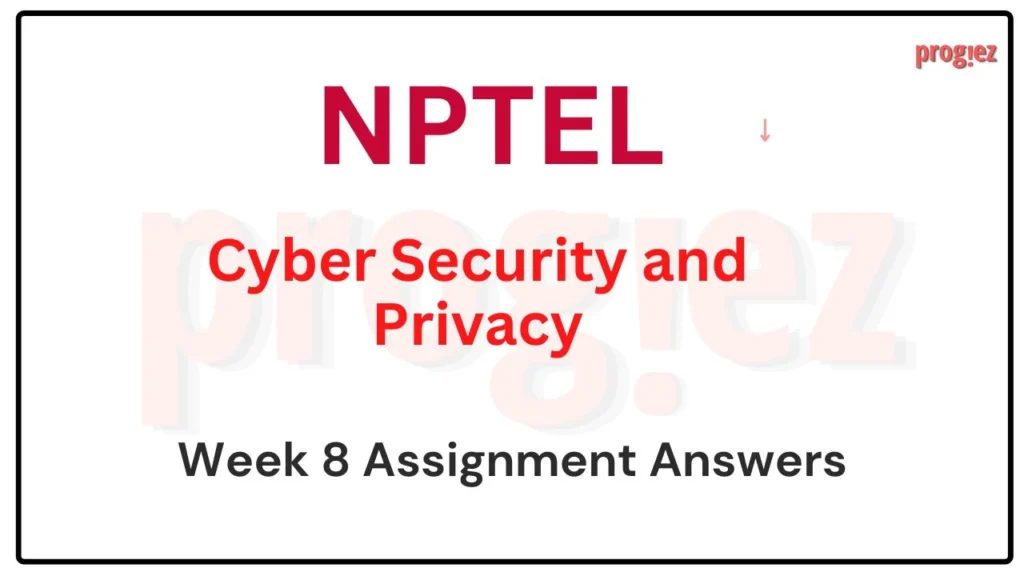
Cyber Security and Privacy Week 8 Nptel Answers (July-Dec 2024)
- The Cost-Benefit Analysis (CBA) formula for risk management decisions is given by:
A) CBA = ALE(prior) – ALE(post) – ACS
B) CBA = ALE(prior) – ALE(post) + ACS
C) CBA = ALE(prior) + ALE(post) – ACS
D) CBA = ALE(prior) + ALE(post) + ACS
Answer: A) CBA = ALE(prior) – ALE(post) – ACS
- In a cost-benefit analysis, _ is the expected percentage of loss that would occur from a particular attack:
A) Single Loss Expectancy
B) Exposure Factor
C) Annualized Loss Expectancy
D) None of the above
Answer: C) Annualized Loss Expectancy
- A __ is a network security device that monitors traffic to or from a network and decides whether to allow or block specific traffic based on a defined set of security rules:
A) Intrusion Detection and Prevention System
B) Router
C) Intrusion Detection System
D) Firewall
Answer: D) Firewall
- What risk management approach aims to minimize the impact of losses resulting from an actual incident, disaster, or attack by implementing thorough contingency plans and preparations?
A) Mitigation risk control strategy
B) Transference risk control strategy
C) Defense risk control strategy
D) Termination risk control strategy
Answer: A) Mitigation risk control strategy
- The product of the asset’s value and the exposure factor is known as:
A) Single Loss Expectancy
B) Annualized Loss Expectancy (Prior)
C) Annualized Rate of Occurrence
D) Annualized Loss Expectancy (Post)
Answer: A) Single Loss Expectancy
- Which of the following is not true?
A) Bit Stream ciphers encrypt data one bit at a time, while block ciphers encrypt data in fixed-size blocks.
B) Bit Stream Cipher is used for Data in Transit Encryption, whereas Block Cipher is used for Data at Rest Encryption
C) Bit Stream Cipher can operate as a Block Cipher but Block Cipher cannot operate as a Bit Stream Cipher
D) Bit Stream ciphers are generally considered faster than block ciphers.
Answer: B) Bit Stream Cipher is used for Data in Transit Encryption, whereas Block Cipher is used for Data at Rest Encryption
These are Cyber Security and Privacy Week 8 Nptel Answers
- The False Acceptance Rate (FAR) in biometrics refers to:
A) The system mistakenly accepting an unauthorized user.
B) The system correctly rejecting an unauthorized user.
C) The time it takes for a system to identify a user.
D) The user’s frustration with the authentication process.
Answer: A) The system mistakenly accepting an unauthorized user.
- The IAAA framework in the context of access control stands for?
A) Isolation, Authentication, Authorization, Availability
B) Identification, Authentication, Authorization, Accountability
C) Inspection, Authentication, Access, Authorization
D) Intrusion Detection, Analysis, Authorization, Administration
Answer: B) Identification, Authentication, Authorization, Accountability
- What is a significant challenge associated with symmetric key encryption?
A) Slower encryption and decryption compared to asymmetric methods.
B) Limited compatibility with modern encryption algorithms.
C) Higher computational cost for key generation.
D) Key management: securely distributing and safeguarding the shared key.
Answer: D) Key management: securely distributing and safeguarding the shared key.
- In risk management, which equation is used to calculate the expected loss per risk?
A) Single Loss Expectancy (SLE) = Asset Value × Exposure Factor (EF)
B) Annualized Loss Expectancy (ALE) = Single Loss Expectancy (SLE) × Annualized Rate of Occurrence (ARO)
C) Asset Value = Single Loss Expectancy (SLE) × Exposure Factor (EF)
D) Annualized Rate of Occurrence (ARO) = Asset Value × Single Loss Expectancy (SLE)
Answer: B) Annualized Loss Expectancy (ALE) = Single Loss Expectancy (SLE) × Annualized Rate of Occurrence (ARO)
These are Cyber Security and Privacy Week 8 Nptel Answers
All Weeks of Cyber Security and Privacy: Click here
For answers to additional Nptel courses, please refer to this link: NPTEL Assignment
Cyber Security and Privacy Week 8 Nptel Answers (JULY-DEC 2023)
Course Name: Cyber Security and Privacy
Course Link: Click Here
These are Cyber Security and Privacy Nptel Week 8 Assignment 8 Answers
Q1. Which of the following terms describes the process of making and using codes to secure the transmission of information?
Algorithm
Cryptography
Steganography
Cryptanalysis
Answer: Cryptography
Q2. What is term is used to describe a cryptographic method that incorporates mathematical operations involving both a public key and a private key to encipher or decipher a message?
Private-key encryption
Symmetric encryption
Advanced Encryption Standard (AES)
Asymmetric encryption
Answer: Asymmetric encryption
These are Cyber Security and Privacy Nptel Week 8 Assignment Answers
Q3. A substitution cipher that incorporates two or more alphabets in the encryption process is called——————-
Monoalphabetic substitution
Block cipher substitution
Stream cipher substitution
Polyalphabetic substitution
Answer: Polyalphabetic substitution
Q4. The current standard for the encryption of data, as specified by NIST ——— is based on the Rijndael algorithm, which was developed by Vincent Rijmen and Joan Daemen.
DES
RSA
AES
Message Digest
Answer: AES
These are Cyber Security and Privacy Nptel Week 8 Assignment Answers
Q5. True or False:
Nonrepudiation means that customers or partners can be held accountable for transactions, such as online purchases, which they cannot later deny.
True
False
Answer: True
Q6. Limited-use symmetric keys for temporary communications during an online session is called
Session keys
One-time padding
AES
DES
Answer: Session keys
These are Cyber Security and Privacy Nptel Week 8 Assignment Answers
Q7. Match the following
Choose the correct answer
A-3, B-5, C-4, D-1, E-2
A-2, B-1, C-4, D-5, E-3
A-4, B-2, C-3, D-1, E-1
A-5, B-2, C-3, D-1, E-4
Answer: A-2, B-1, C-4, D-5, E-3
These are Cyber Security and Privacy Nptel Week 8 Assignment Answers
Q8. Suppose that everyone in a group of N people wants to communicate secretly with the N-1 others using a symmetric key cryptographic system. Communication between any two persons should not be decodable by others in the group. The number of keys required in the system as a whole to satisfy the confidentiality requirement is
2N
N(N-1)
N(N-1)/2
(N-1)2
Answer: N(N-1)/2
Q9. Decrypt the following message if it was encrypted using a shift cipher with a shift of 3.
Message: NPTELINFORMATION
Q S W H O L Q I R U P W L R Q
Q S W H O L Q I T U P W L R Q
Q S W F O L Q I R V P W L R Q
Q S W H O L Q I R V P W L R Q
Answer: Q S W H O L Q I R U P W L R Q
These are Cyber Security and Privacy Nptel Week 8 Assignment Answers
Q10. ————security protocols are used to protect e-mail
SMTP
HTTPS
S/MIME, PEM, and PGP
Telnet
Answer: S/MIME, PEM, and PGP
Q11. What is the most popular encryption system used over the Web?
Diffie Hellman key exchange
RSA
Block cipher
DES
Answer: RSA
These are Cyber Security and Privacy Nptel Week 8 Assignment Answers
More Weeks of Cyber Security and Privacy: Click here
More Nptel Courses: Click here
